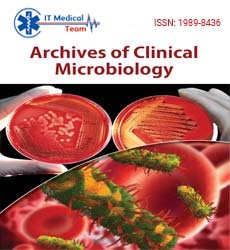Susana Aaron*
Department of Microbiology and Immunology,
Medical Center-Dartmouth Medical School, NH,
United States
- *Corresponding Author:
- Aaron S
Department of Microbiology and Immunology
Medical Center-Dartmouth Medical School
NH,
United States
E-mail: susanaaron@gmail.com
Received Date: June 11, 2021; Accepted Date: June 25, 2021; Published Date: June 30, 2021
Citation: Aaron S (2021) Virion – An Infectious
Agent. Arch Clin Microbio Vol.12 No.S3:e001.
Description
Virion, a whole infection molecule, comprising of an external
protein shell called a capsid and an internal centre of nucleic
corrosive (either ribonucleic or deoxyribonucleic corrosive-RNA or
DNA). The center gives infectivity, and the capsid gives explicitness
to the infection. In certain virions the capsid is additionally
encompassed by a greasy layer, where case the virion can be
inactivated by openness to fat solvents like ether and chloroform.
Numerous virions are spheroidal-really icosahedral—the capsid
having 20 three-sided faces, with consistently organized units
called capsomeres, two to at least five along each side; and the
nucleic corrosive is thickly wound inside. Different virions have a
capsid comprising of an unpredictable number of surface spikes
and the nucleic corrosive approximately snaked inside. Virions of
most plant infections are pole formed; the capsid is a stripped
chamber (without a greasy layer) inside which lies a straight or
helical bar of nucleic corrosive.
• The virion shell or capsid secures the inside center that
incorporates the genome and different proteins. After the
virion ties to the outside of a particular host cell, its DNA or
RNA is infused into the host cell and viral replication happens,
bringing about the spread of the disease to other host cells.
• A virion is the irresistible molecule that is intended for
communicating the nucleic corrosive genome among hosts or
host cells.
• Virions are delivered in the cytoplasm of complex viral
'processing plants,' the infection.
A virion is a whole infection molecule comprising of an external
protein shell called a capsid and an inward center of nucleic
corrosive (either ribonucleic or deoxyribonucleic corrosive—
RNA or DNA). The center presents infectivity, and the capsid
gives particularity to the infection. In certain virions the capsid is
additionally encompassed by a greasy film, where case the virion can be inactivated by openness to fat solvents like ether and
chloroform. Numerous virions are spheroidal—really icosahedral
(the capsid having 20 three-sided faces)— with routinely organized
units called capsomeres, two to at least five along each side. The
nucleic corrosive is thickly looped inside. Different virions have a
capsid comprising of an unpredictable number of surface spikes,
with the nucleic corrosive inexactly wound inside. Virions of most
plant infections are bar molded; the capsid is a stripped chamber
(without a greasy layer) inside which lies a straight or helical bar
of nucleic corrosive.
Virion capsids are shaped from indistinguishable protein subunits
called capsomeres. Infections can have a lipid "envelope" got
from the host cell film. The capsid is produced using proteins
encoded by the viral genome and its shape fills in as the reason
for morphological differentiation. Virally coded protein subunits
will self-gather to shape a capsid, overall requiring the presence of
the infection genome. Complex infections code for proteins that
aid the development of their capsid. Proteins related with nucleic
corrosive are known as nucleoproteins, and the relationship
of viral capsid proteins with viral nucleic corrosive is known as
a nucleocapsid. The capsid and whole infection design can be
precisely (actually) examined through nuclear power microscopy.
38277





